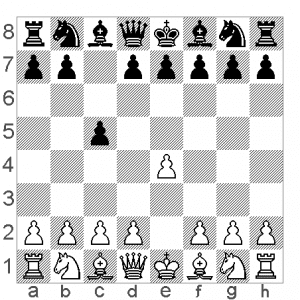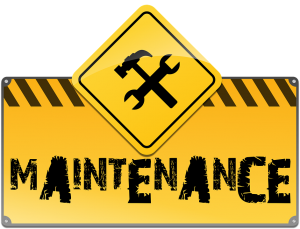Most of my students are normal club players. They don’t have a vast amount of time and are forced to follow the rules of pragmatism. Studying sharp and complex main lines normally is not an option for them. In case a specific student isn’t happy with his White-repertoire and didn’t spent his whole live learning 1.e2-e4 or is a full-fledged attacking player, disdaining positional chess, I suggest to consider adopting the English Opening (or the Reti or both), in order to build up a pragmatic White repertoire, supposed to last a lifetime. This topic mainly regards 1.d4-players, since the 1.e4-universe normally is too alien to the rest (even though I myself did change from 1.e4 to 1.c4 and, more importantly, positional 1.e4-players like Michael Adams and Peter Shvidler adopted 1.c4 as a supplement to their 1.e4 service, in order to be more flexible).
Since I am constantly improving my personal 1.c4 skills, with the aim to possess something like 1.500 variation trees in the next couple of years, I consider myself as a good mentor for everyone, trying to forge a powerful 1.c4-weapon for himself. I prepared the following list of aspects, you might want to consider before making such a decision:
1. High Quality
The English Opening is a high quality opening. If you look into ChessBase’s online database, you will see, that the results are similar to the ones of 1.e4 and 1.d4. It has been used by almost every World Champion. Even Fisher, who declared 1.e4 was “the best by test” resorted to it towards the end of his career, even two times in his 1972 world championship match with Spassky, where he won both games. Fifteen years later in Seville, Kasparov relied on the English as his principal weapon as White in his world championship match against Karpov.
2. Structural Flexibility
The English is a flexible opening with regard to structure and style and offers a rich variety of choices. Each of them leads to a position of different nature, either very calm and dry on one end or extremely dynamic on the other. It is this structural richness, which attracts players of such different style as Andersson and Kasparov. No matter whether you prefer slow maneuvering or fierce attacking play, the occupation of the centre with pawns or hypermodern piece control, the English will provide you with a respective line.
3. Easy to learn
Even though the English Opening gives you the opportunity for sharp play, it basically is a positional opening with a rather slow pace. There is no specific necessity to learn a vast quantity of concrete variations. On a club player level it is fully sufficient to acquaint oneself with the most important pawn structures and piece placements, apart from some very basic theory.
4. Easy to get started
There is no specifically great danger of losing, even if your opponents answer catches you unprepared. The reason for that is simple: You as White have it in your hand to choose the character of the game. Since there is a strong bias to the calm side, it shouldn’t be a problem to steer the game into that direction, when you start out. In a calm positions, you always get away with improvising, if necessary.
5. Easy to maintain
You might put a lot of effort into building up an aggressive mainline-based repertoire with 1.e4, which is able to endanger strong opponents and let all Sicilian players run for the hills. Congratulation for this achievement, but please be aware, that it doesn’t stop there. To maintain such a demanding race car needs constant effort. Hopefully, you are equipped with the newest Informator and New in Chess Yearbook and also study TWIC every two weeks. Otherwise, you might run unprepared into a strong novelty in one of your many sharp lines. And there is more. Don’t forget to browse through the thicket of your repertoire on a regular base. Otherwise, you might forget a line or two.
Needless to say, that the English Opening doesn’t consume that much energy. The number of lines is manageable. If you forget a move, it is not the end of the world. After all, you play strategy-orientated positions, where single moves can be deducted by principles. And a novelty will hardly turn around the evaluation of a position in one of your rather easy-going lines.
6. Playing for 2 Results
Many players hate losing so much, that they feel attracted to positions, where the opponent doesn’t have any significant winning chances. Provided that we are talking about theoretically relevant positions and not about cases of clearly inferior play by the opponent, the 2-results-strategy comes with a price: You can hardly lose, but your own winning chances are also limited and the draw rate is rather high. This fact, however, is no deterrent for players with a lot of patience and a good technique. They are prepared to push small advantages, and accumulate them, in order to end up in a superior ending. Very often, their opponents break under this permanent pressure and throw away their position, which would have been drawn by correct defense.
One good thing about the 2 result-strategy is, that you can clearly see your first move advantage. Consider, on the other hand, a complicated position of the Sicilian Najdorf or Semi-Slav. Could you tell there instantly, whether one side has an advantage and which side it is? Not always, I would say. The English Opening, on the contrary, mostly brings about positions, where everybody can easily perceive, that White has a positional initiative, which still has to be neutralized by Black.
7. Badly prepared Opponents
This one is a very serious advantage. As you might know from your own experience, most players have a distinct antidote against 1.e4 and 1.d4. It simply is worth investing a lot of time, because you meet these principal moves so often. Additionally, play might be rather sharp here, so you are better prepared. The English on the other hand, occurs with far less frequency. And then, the occurring positions are of calmer nature and appear less threatening. Many players think, they can get away with improvising here. It is plain to see, that the English player generally face rather badly prepared opponents. Often, the outcome of the opening is a position with a static advantage to White and a favorable version of the 2-result-strategy, as given above.
8. Preservation of Winning Potential
After 1.e4 or 1.d4, there are a lot forced lines which lead to the exchange of many pieces. In the end, your winning potential might be diminished, because most of your pieces are watching the battle from the sidelines. Of course, this is a problem against weaker opponents. In the English Opening, play generally is less forced. In most cases, the board will be full of pieces until the late middle game. This leaves you with many different roads to victory.
9. Outplaying weaker Opponents without Risk
What is the best strategy when meeting a stronger opponent? Safe play, avoiding complications or energetic and sharp actions? Contrary to what some people might think, you best bet is to go for your superior opponents throat whenever you can. Of course, if you are a full-fledged positional player with poor tactical skills, your chances are limited here, as well. But I am arguing in general terms. If you play a long positional game against a stronger opponent, the normal course of the game will see you committing one small error after the other, slowly but surely accumulating your disadvantage. Your opponent will patiently turn the vice one round after the other. In the end, you never had a realistic change to escape your predestined fate.
However, if you go for a sharp opening line, maybe a gambit, events might take a different turn. Your opponent, by not meeting the theoretical demands of the position might end up in an inferior position. Or he falls victim to a miscalculation. Most of the time, a third phenomenon will kick in, which not everybody is aware of. You opponent will deliberately execute second best moves, in order not to lose the control of the game. His reasoning is, that the normal outcome will be his victory. So, why take the risk and go for a sharp line, which looks best but might contain a hole somewhere? By opting for a couple of these safe but second best moves, he will have to concede a lot of positional equity to you, which is your chance to get your draw in the end.
As you might have imagined, all this just was a prelude of what comes now. In the English Opening you don’t get complicated positions without your consent. Against weaker opponents, you will simply choose a line which is void of tactical moments, but full of profound positional requirements. When executing 1.c4 against a weaker opponent, you will feel secure and self-confident, knowing that everything you have to do for victory is to patiently turn the vice one round after the other….
10. Room for Creativity
In contrast to 1.e4 and 1.d4, there are still a lot of white spots on the English map. If you are a creative player, there will be enough opportunities for you to step on unexplored territory. You might even achieve intellectual immortality by uncorking an important novelty. More importantly, many positions, as a result of not being as concrete in nature as the ones arising from 1.e4, offer space for your individual interpretation. Thus, you personal style, taste or your artistic talent will not be hindered by narrow boundaries.

11. Sidelining your Opponent
The possibility to surprise your opponent with a sideline in the English Opening is quite high. After all, he will be less well prepared here as against 1.e4 or 1.d4. Since sidelines are objectively less critical than main lines, the surprise effect is very important.
Embarking in a sideline or even uncharted territory can be a good recipe against book players. The sooner they are on their own, the better. This is even more applicable against weaker players. In the English Opening, they cannot save themselves into a drawn ending by unspooling a long forced theoretical line they have learned by heart. No. Here, neither their good memory nor their eagerness to study theory will be of help. They have to come up with good chess and if they fail, you will get the point.
12. Psychological Chess
Most positions in the mainlines of 1.d4 and especially 1.e4 are of rather concrete nature. There, the requirements force you to find the best move, because the gap between the best and second best move sometimes is considerable.
In contrast to that, the English Opening gives you a bit more freedom in that respect. Very often the best three moves don’t differ much in value. In such environment psychological tools like changing the rhythm, prophylaxis, trapping, provocation, camouflaging, or doing nothing in an annoying way etc. can be applied with much higher frequency.
13. Sicilian Synergy
In my opinion every Sicilian player should seriously consider to play the English. After 1..e5, which is the most principled answer, and the only you could possible fear (this is absolutely unnecessary in my opinion, but many players prefer to start with 1.Nf3 in order to prevent 1..e5, and follow-up with c4 in the second move), you receive a reversed Sicilian. In many cases you can apply the same patterns from your black Sicilian. By using your knowledge again, in a different context, you definitively safe energy.
14. Improved Sicilian
In both, the original Sicilian and the reversed Sicilian, you play by the same basic idea or spirit. In any case, you bet on the better pawn structure which is a long term advantage. If the opponent will be unable to exploit his short term assets (active piece play) one way or another, you will prevail in the end. In contrast to the white side of the Open Sicilian, the black side of the Reversed Sicilian won’t have the same attacking options. Let’s take the main line 1.c4 e5 2.Nc3 Nf6 3.Nf3 Nc6 4.g3 d5 5.cxd5 Nxd5 6.Bg2. Here Black has to play the defensive 6..Nb6 in order to meet 7.Nxe5-ideas, which basically gives White two extra tempi in a Reversed Dragon which is completely harmless. No resemblance with the feared Yugoslavian Attack at all.

15. Teaming up with the Reti and the KIA
For a Reti player or a protagonist of the King’s Indian Attack, it is no big deal to switch to the English or widen the repertoire respectively. Both are openings with a modern spirit and so is the English. If you are able to play both, the Reti and the English, you are far more flexible and can do a bit of cherry picking. For instance, if you should happen to dislike 1.c5 e5, you simply start with the Reti move 1.Nf3. Vice versa, if you have problems with the Dutch after 1.Nf3, you might retain more flexibility against those Dutch player by starting with 1.c4. After 1..f5 you are prepared to answer with the Botwinnik-setup 2.Nc3, 3.g3, 4.Bg2, 5.d3 and 6.e4, to give but one example.
16. Circumventing unpleasant anti-1.d4 lines
For each 1.d4-player, it would be a blessing to have 1.c4 in his repertoire as well. With this powerful double weapon, he could react with the highest degree of flexibility, reacting according to his specific opponent. Let’s say he doesn’t want to allow the Modern Benoni, the Benko, the Queen’s Gambit Accepted, the Queen’s Gambit Tarrasch, the Nimzo-Indian or the Tschigorin Defence. All he would have to do is to start with 1.c4.
17. Cherry-picking pleasant anti-1.d4 lines
Let’s say further, that the same player would embrace the idea to meet the Queen’s Gambit Declined or the King’s Indian Mainline. After 1.c4 e6 2.Nc3 d5, he would simply transpose with 3.d4 into the QGD and be happy. Against his King’s Indian opponent, the game would continue 1..Nf6 2.Nc3 g6 3.e4 (avoiding Gruenfeld, if desired) Bg7 4.d4 and so on.
18. Better versions of anti-d4 openings
The real fun with 1.c4 starts, when you meet opponents who are hoping to reach their anti-1.d4-system in the English by means of transposition. While this is possible, if White complies, it can lead to problems, if Black insists too much. Let me point this out:
a) Anti-Gruenfeld
Almost every Gruenfeld player will answer 1.c4 Nf6 2.Nc3 with 2..d5, hoping that White will cooperate and follow up with d4 at some point, thus reaching the standard positions the Gruenfeld player is craving so much. To his regret, however, after 3.cxd5 Nxd5 White possesses a great many of alternatives: 4.Nf3 g6 5.Qa4, 5.Qb3 or 5.e4 Nxc3 and now 6.dxc3 (instead of 6.dxc3). As especially unpleasant for Black, however, I consider 4.g3 g6 5.Bg2. Black is now confronted with the unattractive options to either fortify White’s pawn structure with 5..Nxc3 6.bxc3, giving him good play in the b-file on top of this, or to lose a tempo with 5..Nb6 for putting this knight on a rather passive place.
Since White avoids playing d4, Black is without a clear target and has no idea to actively win the game. In contrast to that, White disposes of a clear route to improve his position, which basically is a minority attack on the queenside. Consequently, this line is a play for two results: 0.5 or 1-0. Needless to say, that this is my personal weapon against the Gruenfeld.
b) Anti-Dutch-Stonewall
Even worse than the Gruenfeld player fares the Stonewall fan, who rigidly wants to cling to his setup. After 1.c4 f5 2.Nc3 Nf6 3.g3 e6 4.Lg2 c6 5.Nf3 d5 6.0-0 Bd6 7.d3! 0-0 8.e4!, the stonewall is about to be torn down. As a result, White will exploit the bunch of weakened squares as well as the insecure position of the king. It comes as no surprise, that this line performs with 80% in the ChessBase’s online database. The underlying logic should be clear: The Stonewall can only function after White lost control over e4 by playing d4. A deliberately used the term “should”, since you can find as much as 400 games on this subject. I too had the pleasure once to play an “English Stonewall” with White.

c) Anti-Dutch Leningrad
The Leningrad Variation is much more solid than the Stonewall is can’t be refuted just like that. White however, has a very pragmatic setup at his disposal, which relies on understanding patterns rather than rote-learning of variations: 1.c4 f5 2.Nc3 Nf6 3.g3 g6 4.Bg2 Bg7 5.d3 d6 6.e4 Nc6 (c6) 7.Nge2 e5 8.0-0 0-0. This system, known as Botwinnik setup, is not without poison, and allows White to easily overplay his opponent, if he is shouldn’t be familiar with the typical plans and manoeuvres. The knowledge of this structure has an economic aspect as well. It is also applicable against the King’s Indian as well as in one of the English main lines: 1.c4 e5 2.Nc3 Nc6 3.g3 g6 4.Bg2 etc. By studying the Botwinnink setup, you could kill several birds with one stone.
d) Anti-King’s Indian
As mentioned above, you could meet the King’s Indian by unspooling Botwinnik’s routine. After
1.c4 Nf6 2.Nc3 g6 3.g3 Bg7 4.Bg2 0-0 5.d3 e5?! 6.e4! we can already claim a slight but distinct advantage to White. Compared to the Leningrad, Black’s f-pawn is hemmed by the knight. Hence, I consider it more prudent for Black to continue with 5..d6, in order to follow up with 6.e4 c5! Here, Black has better chances for equality, even though he still has to neutralize White’s initiative. An interesting idea for White is 6.Rb1, with the idea to answer 6..e5 with 7.e4!?. By sacrificing half a tempo, you circumvent the setup with c5. I was quite successful with this in numerous blitz games.
e) Anti-Nimzoindian
If the Nimzo player wants to impose his structure on the English, he has to play 1.c4 Nf6 2.Nc3 e6 3.Nf3 Bb4. But instead of complying now with 4.d4?!, White rather continues with 4.Dc2!. After
4..0-0 5.a3 Bxc3 6.Qxc3 White got hold of the bishop pair. He will now follow up with b4 (or more restraint with b3) and Bb2 with a static advantage. In contrast to the Nimzoindian, White saved a tempo he could invest in his development and also didn’t expose himself with d4, thus not giving Black an opportunity to open up the position in order to exploit his lead in development.
f) Anti-Queen’s Indian
I play the Nimzoindian myself and I can reassure you: We Nimzo players, we do love our bishop pair! If we give it up, it must be for a good reason. Since, the English Anti-Nimzoindian doesn’t yield good value for this sacrifice, the more popular choice here is to go for a Queen’s Indian instead: 1.c4 Sf6 2.Nc3 e6 3.Nf3 b6. But this also comes with specific problems: After 4.g3 Bb7 5.Bg2 Be7 6.0-0 0-0
White has two options: He can allow the Queen’s Indian with 7.d4, benefiting from the fact, that with this specific move order, he steered clear from all lines with an early Bb4+ and, more importantly, from the strong Nimzowitsch Variation 1.d4 Nf6 2.c4 e6 3.Nf3 b6 4.g3 Ba6. A considerable achievement. Alternatively, he can opt for the popular 7.Re1, destroying all Black Queen’s Indian fantasies instantly.
I hope I could give you some ideas regarding the English Opening, but also, in more general terms, information about how to consider all kinds of different aspects, when building up an opening repertoire.


